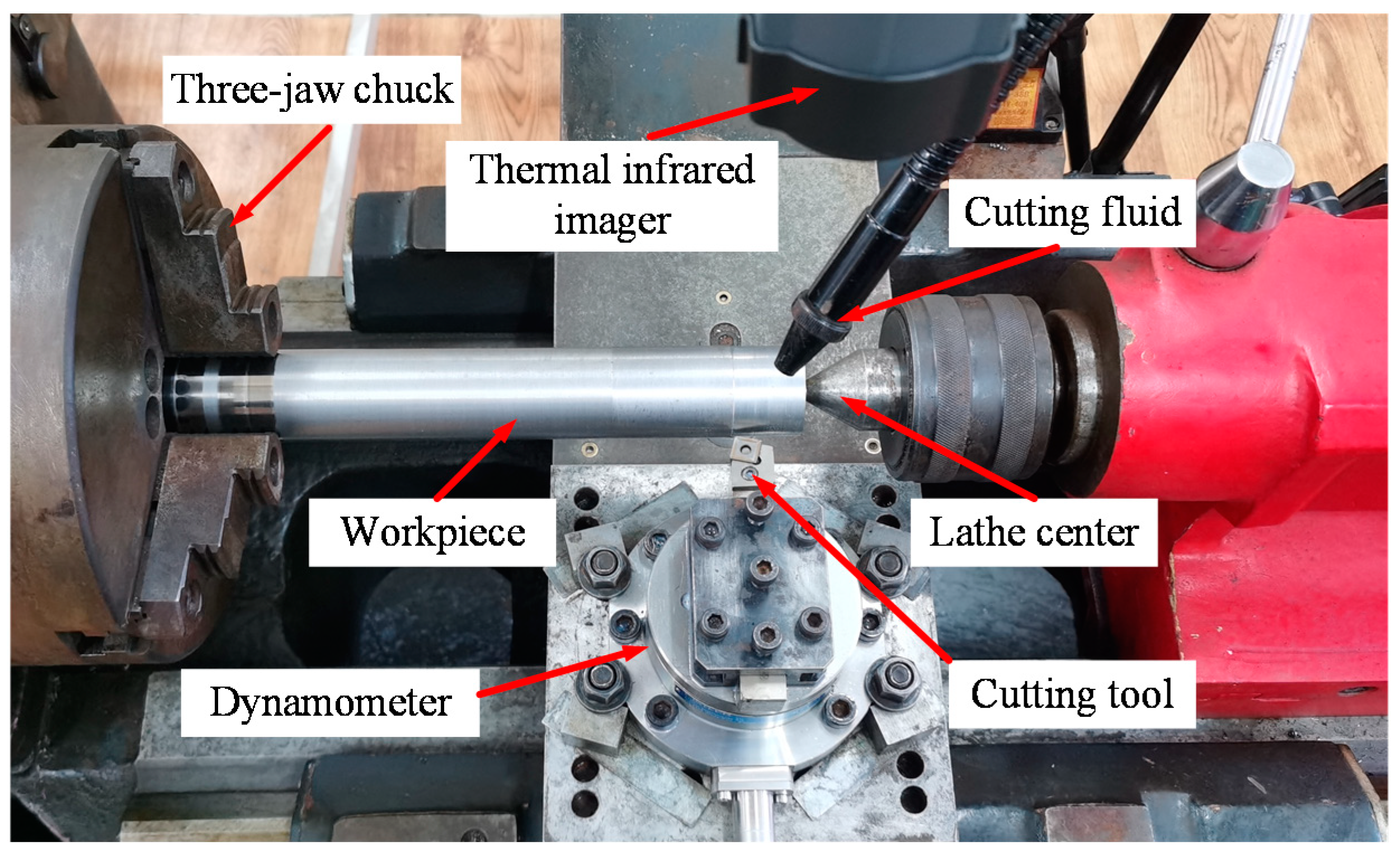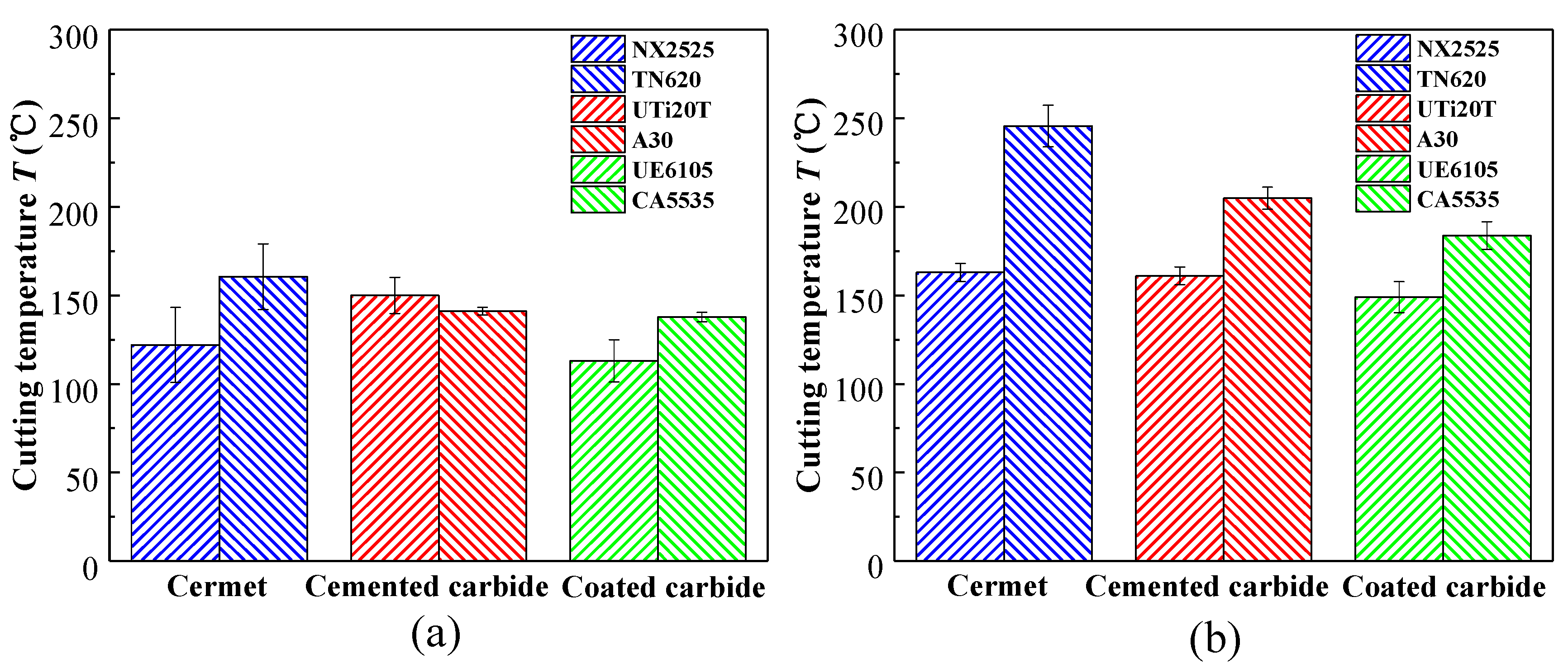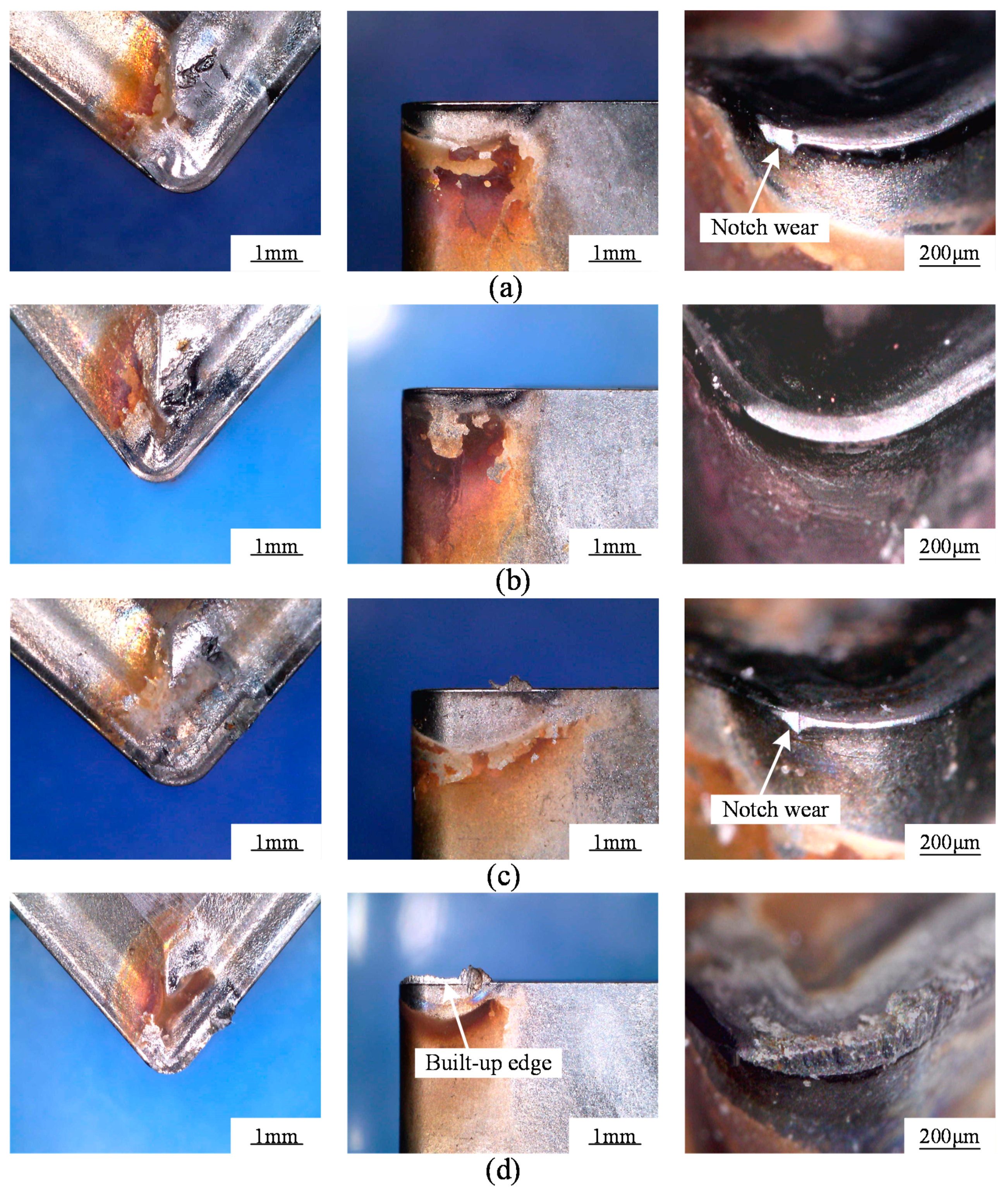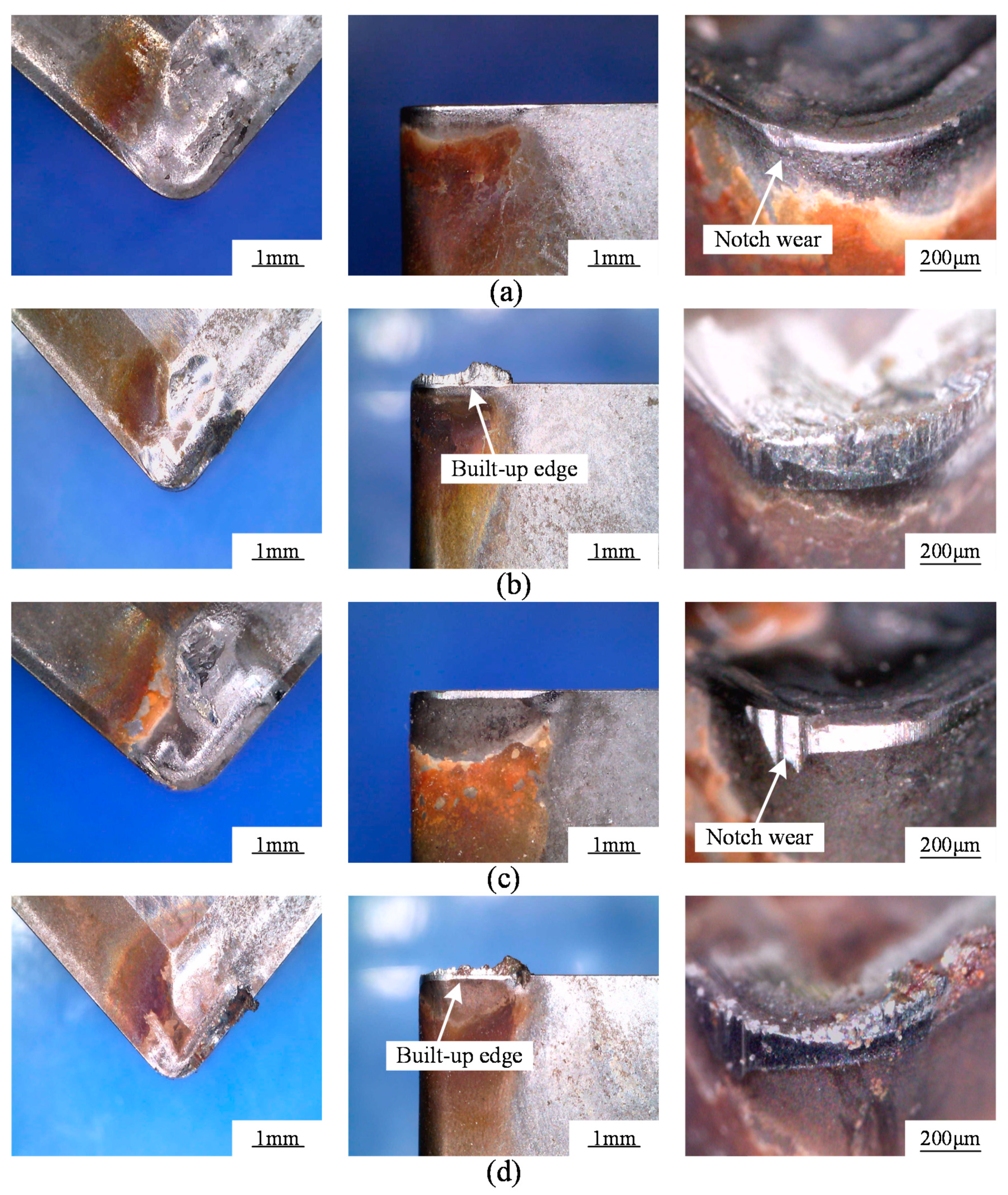1. Introduction
In recent years, many ships have been in distress, among which the capsizing accident is particularly serious [
1]. In emergency rescues of capsized ships, it is usually necessary to cut a hole in the hull to rescue trapped people [
2,
3]. Nowadays, marine steels with excellent properties are widely used in shipbuilding. As is known, marine steels belong to high-strength steels, which are difficult to machine with high cutting temperature [
4], difficulty in chip breaking [
5], built-up edge [
6], severe tool wear [
7], etc. Meanwhile, for the tool used to cut the hull, the cutting process should meet the following requirements [
8]: a small cutting force to make the cutting process smooth and reduce power consumption with lightweight rescue equipment, a low cutting temperature to avert a gas explosion inside the ship, small surface roughness of the hole to avoid hurting the rescued people and a long tool life to make the cutting process efficient and reliable without changing tools. However, there is little research into the machinability of marine steels.
Ravi et al. [
9] demonstrated that the cryogenic cooling decreased the cutting force, cutting temperature, surface roughness and tool wear in the cutting of hardened D3 steels with cemented carbide tools. Szczotkarz et al. [
10] reported that the wear of coated carbide tools decreased when turning 316 L steels with minimized lubrication. Özbek et al. [
11] investigated the effects of vibration and cutting temperature on surface roughness and tool wear in the turning of AISI D2 steels using coated carbide tools. Fernández-Abia et al. [
12] found that a high cutting speed was beneficial for the machining of austenitic steels with coated carbide tools, although the tool wear was high. Zou et al. [
13] reported that the cermet tool life was mainly affected by the cutting speed when machining stainless steels. Sarjana et al. [
14] pointed out that in the turning of hardened steels, the uncoated cermet tool was better in the amount of material removal, while the coated cermet tool was better in the quality of surface finish. Li et al. [
15] found that the multi-coated tool was suitable for the high-speed milling of AISI 4340 steel due to the high resistance of element diffusion. Boing [
16] reported that the increase of tool wear rate with the cutting speed was different for each tool material in the hard turning of AISI 52100 steel.
As stated above, the tools of cemented carbide, coated carbide and cermet are commonly chosen for the cutting of high-strength steels. Moreover, different tool materials presented various cutting force [
17], cutting temperature [
18], surface quality [
19] and tool life [
20]. Thus, the requirements for the cutting of capsized steel ships can be met by selecting a suitable tool material. Besides, because the cutting conditions and requirements in the cutting of a steel hull are different from those in production, the cutting performances of tool materials need to be evaluated by multiple evaluation indexes of cutting force, cutting temperature, surface quality and tool life.
Several scholars have studied the applications of evaluation methods in the engineering field. Taha et al. [
21] developed a machine tool selection system based on the fuzzy analytic hierarchy process and artificial neural network. Cheng et al. [
22] evaluated the performance of layer face milling cutters concerning structures and geometrical parameters in the milling of 508III steels by a multi-level fuzzy evaluation system. Choudhuri et al. [
23] optimized parameters for multiple performance features in the machining of 316 stainless steels by the grey-fuzzy algorithm. Gok [
24] used the fuzzy TOPSIS, multi-objective grey design and RSA in the cutting of ductile irons and obtained the smallest cutting force and the best surface quality. Xu et al. [
25] accomplished the optimal selection of tool materials for the machining of high-strength steels based on the fuzzy evaluation method. Yue et al. [
26] adopted the grey-fuzzy analytic hierarchy method to evaluate the tool cutting performance in the milling of titanium alloy.
Based on the cited researches, it is clear that the fuzzy evaluation method can make a quantitative evaluation of the objects affected by multiple factors. However, there is little research into the evaluation of tool cutting performance for the cutting of marine steels. For the cutting of marine steels under special conditions and requirements in emergency rescues of capsized steel ships, it is necessary in particular to evaluate the cutting performances of different tool materials concerning cutting force, cutting temperature, surface roughness and tool wear by the fuzzy evaluation method.
In this research, the fuzzy evaluation method was adopted to select the optimum tool material for the cutting of marine steels among the cermet tools, cemented carbide tools and coated carbide tools with considerations of cutting force, cutting temperature, surface roughness and tool wear. This work can provide reliable theoretical and technical references for the cutting of marine steels in emergency rescues of capsized steel ships.
Author Contributions
Conceptualization, Q.X.; methodology, Q.X. and J.L.; validation, J.L.; formal analysis, J.L.; investigation, G.C., D.J. and J.Z.; resources, Q.X.; data curation, J.L., G.C., D.J. and J.Z.; writing—original draft preparation, Q.X. and J.L.; writing—review and editing, Q.X. and J.L.; visualization, J.L.; supervision, Q.X.; project administration, Q.X.; funding acquisition, Q.X. All authors have read and agreed to the published version of the manuscript.
Funding
The research was sponsored by the Joint Funds of the Natural Science Foundation of Liaoning (Grant No. 2020HYLH43), the Dalian Science and Technology Innovation Fund Project (Grant No. 2020JJ25CY016) and the Fundamental Research Funds for the Central Universities of China (Grants Nos. 3132019352 and 3132019308).
Institutional Review Board Statement
Not applicable.
Informed Consent Statement
Not applicable.
Data Availability Statement
The data presented in this study are available on request from the corresponding author.
Conflicts of Interest
The authors declare no conflict of interest.
References
- Wang, Z.W. Current development of rescue and salvage equipments. J. Mech. Eng. 2013, 49, 91–100. [Google Scholar] [CrossRef]
- Huang, R.H. Rescue of capsized iron ships. World Ship 2013, 36, 14–17. [Google Scholar]
- Zhao, S.Y. Design of hole-opening equipment applied in seawater for emergency salvage of ships in distress. Ship Ocean Eng. 2017, 6, 50–53. [Google Scholar]
- Xu, Q.Z.; Zhao, J.; Ai, X. Fabrication and cutting performance of Ti(C,N)-based cermet tools used for machining of high-strength steels. Ceram. Int. 2017, 43, 6286–6294. [Google Scholar] [CrossRef]
- Uçak, N.; Aslantas, K.; Çiçek, A. The effects of Al2O3 coating on serrated chip geometry and adiabatic shear banding in orthogonal cutting of AISI 316L stainless steel. J. Mater. Res. Technol. 2020, 9, 10758–10767. [Google Scholar] [CrossRef]
- Song, X.Q.; Takahashi, Y.; He, W.M.; Ihara, T. Study on the protective effect of built-up layer in dry cutting of stainless steel SUS304. Precis. Eng. 2020, 65, 138–148. [Google Scholar] [CrossRef]
- Liu, J.B.; Ji, X.; Guo, Z.X.; Qin, C.T.; Xiao, Y.; You, Q.B. Characteristics and cutting performance of the CVD coatings on the TiCN-based cermets in turning hardened AISI H13 steel. J. Mater. Res. Technol. 2020, 9, 1389–1399. [Google Scholar] [CrossRef]
- Xu, Q.Z.; Chen, L.Y.; Sun, M.J.; Wang, G.J.; Liu, Y. A comparative study of corrosion property, tribological behavior and cutting performance of tool materials for the cutting of marine high-strength steels in the marine environment. Proc. Inst. Mech. Eng. B-J. Eng. 2021, 235, 98–111. [Google Scholar] [CrossRef]
- Ravi, S.; Gurusamy, P. Experimental investigation of cryogenic cooling on cutting force, surface roughness and tool wear in end milling of hardened AISI D3 steel using uncoated tool. Mater. Today Proc. 2020, 33, 3314–3318. [Google Scholar] [CrossRef]
- Szczotkarz, N.; Mrugalski, R.; Maruda, R.W.; Królczyk, G.M.; Legutko, S.; Leksycki, K.; Dębowski, D.; Pruncu, C.I. Cutting tool wear in turning 316L stainless steel in the conditions of minimized lubrication. Tribol. Int. 2021, 156, 106813. [Google Scholar] [CrossRef]
- Özbek, O.; Saruhan, H. The effect of vibration and cutting zone temperature on surface roughness and tool wear in eco-friendly MQL turning of AISI D2. J. Mater. Res. Technol. 2020, 9, 2762–2772. [Google Scholar] [CrossRef]
- Fernández-Abia, A.I.; Barreiro, J.; Lacalle, L.N.L.D.; Martínez, S. Effect of very high cutting speeds on shearing, cutting forces and roughness in dry turning of austenitic stainless steels. Int. J. Adv. Manuf. Technol. 2011, 57, 61–71. [Google Scholar] [CrossRef]
- Zou, B.; Zhou, H.J.; Huang, C.Z.; Xu, K.T.; Wang, J. Tool damage and machined-surface quality using hot-pressed sintering Ti(C7N3)/WC/TaC cermet cutting inserts for high-speed turning stainless steels. Int. J. Adv. Manuf. Technol. 2015, 79, 197–210. [Google Scholar] [CrossRef]
- Sarjana, S.S.; Bencheikh, I.; Nouari, M.; Ginting, A. Study on cutting performance of cermet tool in turning of hardened alloy steel. Int. J. Refract. Met. Hard Mater. 2020, 91, 105255. [Google Scholar] [CrossRef]
- Li, Y.; Zheng, G.M.; Cheng, X.; Yang, X.H.; Xu, R.F.; Zhang, H.Q. Cutting performance evaluation of the coated tools in high-speed milling of AISI 4340 steel. Materials 2019, 12, 3266. [Google Scholar] [CrossRef] [PubMed] [Green Version]
- Boing, D.; Zilli, L.; Fries, C.E.; Schroeter, R.B. Tool wear rate of the PCBN, mixed ceramic, and coated cemented carbide in the hard turning of the AISI 52100 steel. Int. J. Adv. Manuf. Technol. 2019, 104, 4697–4704. [Google Scholar] [CrossRef]
- Li, Y.; Zheng, G.M.; Zhang, X.; Cheng, X.; Yang, X.H.; Xu, R.F. Cutting force, tool wear and surface roughness in high-speed milling of high-strength steel with coated tools. J. Mech. Sci. Technol. 2019, 33, 5393–5398. [Google Scholar] [CrossRef]
- Xu, Q.Z.; Zhao, J.; Ai, X. Cutting performance of tools made of different materials in the machining of 42CrMo4 high-strength steel: A comparative study. Int. J. Adv. Manuf. Technol. 2017, 93, 2061–2069. [Google Scholar] [CrossRef]
- Ajaja, J.; Jomaa, W.; Bocher, P.; Chromik, R.R.; Songmene, V.; Brochu, M. Hard turning multi-performance optimization for improving the surface integrity of 300M ultra-high strength steel. Int. J. Adv. Manuf. Technol. 2019, 104, 141–157. [Google Scholar] [CrossRef]
- Diniz, A.E.; Machado, Á.R.; Corrêa, J.G. Tool wear mechanisms in the machining of steels and stainless steels. Int. J. Adv. Manuf. Technol. 2016, 87, 3157–3168. [Google Scholar] [CrossRef]
- Taha, Z.; Rostam, S. A fuzzy AHP-ANN-based decision support system for machine tool selection in a flexible manufacturing cell. Int. J. Adv. Manuf. Technol. 2011, 57, 719–733. [Google Scholar] [CrossRef]
- Cheng, Y.N.; Jia, W.K.; Nie, W.Y.; Wang, C.; Han, Y. Optimum design and performance evaluation of layer face milling cutter for cutting 508III steel. Int. J. Adv. Manuf. Technol. 2018, 98, 729–740. [Google Scholar] [CrossRef]
- Choudhuri, B.; Sen, R.; Ghosh, S.K.; Saha, S.C. Modelling and multi-response optimization of wire electric discharge machining parameters using response surface methodology and grey-fuzzy algorithm. Proc. Inst. Mech. Eng. B-J. Eng. 2017, 231, 1760–1774. [Google Scholar] [CrossRef]
- Gok, A. A new approach to minimization of the surface roughness and cutting force via fuzzy TOPSIS, multi-objective grey design and RSA. Measurement 2015, 70, 100–109. [Google Scholar] [CrossRef]
- Xu, Q.Z.; Zhao, J.; Ai, X.; Huang, W.M.; Wang, G.J. Optimum selection of tool materials for machining of high-strength steels based on fuzzy comprehensive evaluation method. Proc. Inst. Mech. Eng. B-J. Eng. 2019, 233, 145–153. [Google Scholar] [CrossRef]
- Yue, D.X.; Yue, C.X.; Liu, X.L.; Zhang, A.S.; Li, M.X.; Liang, S.Y.; Li, M. Analysis of cutting performance of the tool based on FEM and grey-fuzzy analytic hierarchy process. Int. J. Adv. Manuf. Technol. 2021. [Google Scholar] [CrossRef]
| Publisher’s Note: MDPI stays neutral with regard to jurisdictional claims in published maps and institutional affiliations. |
© 2021 by the authors. Licensee MDPI, Basel, Switzerland. This article is an open access article distributed under the terms and conditions of the Creative Commons Attribution (CC BY) license (https://creativecommons.org/licenses/by/4.0/).













